IRA repeal is unlikely, analysts say, but there could be some ‘pruning’
Bruce Beaubouef * Houston
With the re-election of former president Donald Trump, some analysts have been pontificating about the fate of the Inflation Reduction Act (IRA), which included $783 billion on renewable energy spending, including various tax subsidies and credits for offshore wind projects.
Before the election, Trump criticized the IRA as being too expensive and promised to rescind all unspent funds allocated by the law. But dismantling the IRA would require lawmakers, including those whose states have benefited from IRA-related investments such as solar-panel factories, wind farms and other projects, to vote to repeal it.
According to the latest analysis from Evercore ISI, a full repeal of the IRA under a new Trump administration and possible Republican Congress is “very unlikely,” but there could be “some pruning.”
Evercore noted that while Trump expressed opposition to the legislation multiple times, “we believe a full repeal of the legislation is highly unlikely, especially given the amount of investment made following the passage of the bill in Republican-dominated districts.”
According to the Department of Energy, of the total spending on clean energy technologies since 2021 (as of mid-2024), ~$10.9 billion was for solar in red states and $4.1 billion in blue states; on batteries spending was $109.9 billion in red states and $22.0 billion in blue states; and on EVs, $35 billion to red states and $4.2 billion to blue states. Furthermore, five of the seven swing states (Georgia, Michigan, North Carolina, Nevada, and Arizona) feature in the top 15 for cleantech investment.
“We believe most of the current legislation will remain intact,” Evercore said, “with the potential for some slight modifications (especially given the skew in investment beneficiaries), like the earlier sunsetting or capping of certain tax incentives, making them more difficult to monetize, or greater domestic content requirements, coupled with the potential easing of certain EPA emissions rules. The Inflation Reduction Act has played a pivotal role in this sector, with clean energy tax credits projected to total between $800 billion and $1.2 trillion over the next decade. In our opinion, it only seems logical that the pillars of the legislation’s foundation would remain.”
Other analysts concurred. “The jobs and the economic benefits have been so heavy in red states, it’s hard to see an administration come in that says, ‘we don’t like this,’” said Carl Fleming, a partner at law firm McDermott Will & Emery, as quoted in a Reuters report. Fleming advised the Biden White House on renewable energy policy.
Many of Trump’s allies also benefit from the IRA through their investments in clean energy technologies. Fleming said Trump could, however, slow things down around the margins by hindering federal agencies that deliver IRA grants and loans, or by reducing federal leasing for things such as offshore wind.
One way Trump could slow the transition is through executive action by changing public lands leasing policy, analysts said. The Biden administration had sought to expand lease auctions for offshore wind in federal waters, along with solar and wind on land.
A new Trump administration could give preference to fossil fuel extraction development on public lands and waters. Such a policy could have an outsized impact on the offshore wind industry, which is aiming to tap into the stronger wind resources further offshore, which means federal waters.
Trump has said he intends to end the offshore wind industry “on day one,” contending that it is too expensive and poses a threat to whales and seabirds. This would be a fairly dramatic policy reversal after his first administration supported offshore wind development. Other analysts have indicated that a new Trump administration could look to curtail – rather than end – offshore wind development by enacting a moratorium on new offshore wind lease sales.
About the Author
Bruce Beaubouef
Managing Editor
Bruce Beaubouef is Managing Editor for Offshore magazine. In that capacity, he plans and oversees content for the magazine; writes features on technologies and trends for the magazine; writes news updates for the website; creates and moderates topical webinars; and creates videos that focus on offshore oil and gas and renewable energies. Beaubouef has been in the oil and gas trade media for 25 years, starting out as Editor of Hart’s Pipeline Digest in 1998. From there, he went on to serve as Associate Editor for Pipe Line and Gas Industry for Gulf Publishing for four years before rejoining Hart Publications as Editor of PipeLine and Gas Technology in 2003. He joined Offshore magazine as Managing Editor in 2010, at that time owned by PennWell Corp. Beaubouef earned his Ph.D. at the University of Houston in 1997, and his dissertation was published in book form by Texas A&M University Press in September 2007 as The Strategic Petroleum Reserve: U.S. Energy Security and Oil Politics, 1975-2005.

